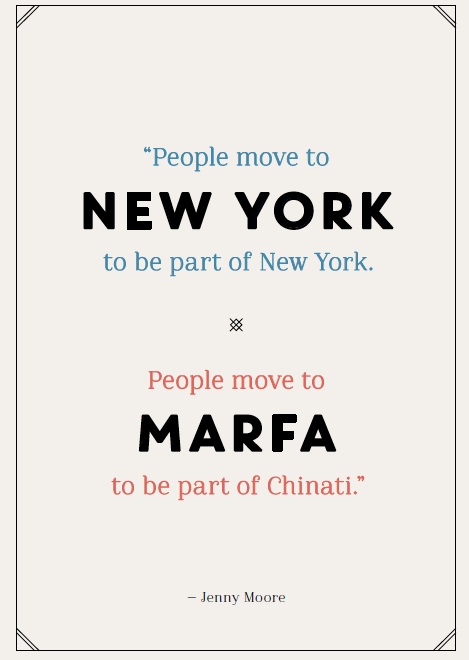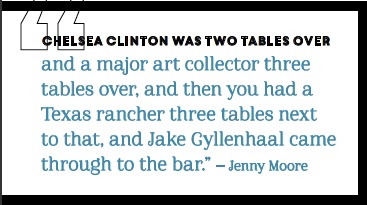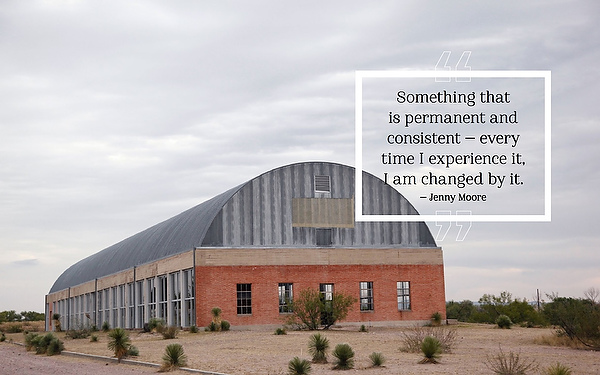Follow me to El Cosmico. You can’t miss this campground with its Christmas lights, refurbished vintage trailers, Sioux-style tepees and safari tents worthy of the Serengeti. It sits on the outskirts of funky Marfa, Texas, and unless you are driving with your eyes closed and your spirit on empty, you can’t miss much of anything in this speck of a town, certainly not the El Cosmico vibe that urges visitors to drop the stress and be here now, under a vast blanket of stars, whipped by winds that sound like the ocean. Only 2,007 people lived in Marfa last year, according to the state’s estimate for 2013. Among them by way of Brooklyn were newcomers Jenny Moore (’95), her husband, installation artist Larry Bamburg, and their two daughters, 5-year-old Mae and 3-year-old Willa.
Why would a Wake Forest graduate, originally from Maryland’s Eastern Shore with brief stops in Venice and a long stretch in New York, wind up in a high plains desert town three hours’ drive from the nearest airport — take your pick — Midland/Odessa or El Paso? Turn right just before you arrive at the campground, and you’ll know why. “People move to New York to be part of New York. People move to Marfa to be part of Chinati,” says Moore.
Since August 2013 Moore has been executive director of the Chinati Foundation, a world-class museum in the middle of nowhere. It is a global treasure, having won a place with the St. Louis Arch and Frank Lloyd Wright’s Taliesin home in Wisconsin, among myriad sites, on the 2014 World Monuments Fund Watch List of architectural and cultural heritage sites worthy of preservation. Every year about 14,000 people visit Chinati, named for the nearby mountain range. They come from New York, Los Angeles, Japan, Germany, France — even Midland.
Moore’s domain encompasses the Chinati Foundation’s 34 buildings on 340 acres, its staff of 28, its $2.3 million budget and its community and global mission. Part of the acreage once was home to U.S. cavalry troops, dispatched in 1911 to stop Pancho Villa’s cattle rustling and protect citizens from raids during the Mexican Revolution. Through the years the military garrison changed names and expanded, eventually becoming Fort D.A. Russell, bustling with troops during World War II and housing prisoners of war. It closed in 1946. But the buildings remain, and in them and alongside them you find Chinati’s treasures — and Moore’s office in a former barracks. The heart of the museum comprises two brick and concrete sheds that once held munitions but now display 100 mill aluminum boxes designed by Donald Judd, the contemporary artist who founded Chinati. The boxes look at first to be uniform and standard, but they are not. Light from huge windows bounces off the boxes, and from the sheds’ interior the view of the desert with its scrub and cacti ever changes, as it does for the 15 massive outdoor concrete works designed by Judd.

The freestanding works in concrete took four years to construct. Judd called space around his work “crucial.”
One March day in her office at Chinati, Moore’s eyes fill with tears: “I still get emotional about this,” she says. “I guess I should — I moved here. The power of an extraordinary art experience, it’s so inspiring. It’s overwhelming. It makes you see the world in a different way. … Walking into those artillery sheds — every single time I walk into those buildings — I see something I’ve never seen before because light is different, or the sky is different, or there are other things on my mind, or I’m with different people, so the conversation is different.”
Against the backdrop of American culture fixated on the next and the new, Chinati offers the opposite — a melding of art, architecture and the environment in which artists have had full control over the conditions in which their art was installed, permanently. “Something that is permanent and consistent — every time I experience it, I am changed by it,” Moore says. “It’s a pretty extraordinary thing to be able to say you’ve found in life and to commit to in life.” That’s a revelation from a woman comfortable in all manner of art venues and whose last job was associate curator at the aptly named New Museum in New York City, a temple of what’s next.
In 1973, the year Moore was born, Judd decided to buy two former airplane hangars in Marfa. On holiday from New York, he and his young family had spent the previous two summers in Marfa. Judd was captivated by the landscape of West Texas as a young soldier passing through in the 1950s. To this day the ethereal quality of light is unforgettable. By 1979 his vision for a new kind of museum was coming to life — with support from the Dia Art Foundation — at the old military base and in other buildings around town. Chinati opened in 1986 and, despite Dia’s and Judd’s parting of ways, remains one of the largest installations of permanent contemporary art in the world, with sculptures by John Chamberlain, a light installation by Dan Flavin and works by such artists as Carl Andre, Claes Oldenburg and Roni Horn, among others, and, through Moore’s guidance, more to come.
“My work and that of my contemporaries that I acquired was not made to be property,” Judd has written. “It’s simply art. I want the work I have to remain that way. It is not on the market, not for sale, not subject to the ignorance of the public, not open to perversion.”
His was a radical notion — a breakaway juggernaut from traditional museum practices of exhibiting singular works temporarily and a shrug to the vicissitudes of the art market. He wanted permanence. He wanted the space surrounding the art to be just as crucial and well thought out as the art itself. Above all, he wanted harmony of art, architecture and land. Moore calls Chinati “the recognition of one person’s vision of something greater than himself, a vision of a place without precedence which became a reality.”
≈
Moore did not have a vision of herself in the desert when she was growing up in Berlin, Maryland, population less than 3,000 then. For a Berliner the vast environment for contemplation was the sea. Moore liked drawing and singing but didn’t know what she might do with her life. Her father was a lawyer, her mother an interior designer. She can’t pinpoint why she picked Wake Forest. At seven hours’ drive it was “close enough to drive but far enough to be away. The campus felt really good.”
She arrived and found her place outside what seemed to her the mainstream of pre-med and business students. She bored her parents silly during one Christmas break talking about facts she had learned in a class about the evolutionary history of humans. Moore recalls how her older sister seemed the only one impressed, repeatedly exclaiming: “Awesome! I didn’t know that!” She chose cultural anthropology as her major, thriving under the guidance of Professor J. Ned Woodall, and picked studio art as her minor with Professor David Helm as a mentor and friend. She signed up for a writing course on faith and the imagination in the religion department. It wasn’t the usual path, she says: “I’m kind of into that, too.”
She hung out in Scales Fine Arts Center. She built sculptures in the courtyard. She liked her college experience despite finding herself “at odds” with many students’ political views. In retrospect she says the experiences strengthened her friendships and defined her intellectual and cultural sensibilities. Helm, a sculptor who left to become an art professor at the University of Nebraska, Omaha, recalled in an email how Moore was “at the heart of a group” of students eager “to question and solve philosophical questions, to expand upon growing artistic trends (and) to bridge various academics with the arts.” He found unforgettable her smile, sparkle and style — and “Jenny’s vintage leather jacket.”
Her style is on full display at Chinati, with her black and white boutique clothes on her wispy frame. She claims to love burritos, but she’s thinner than most burrito eaters I’ve encountered in Texas. She looks straight out of Williamsburg in Brooklyn, her home for seven years. She sits in a white office, her desk covered with neat piles of paper and with art books nearby. She takes a Chinati board member’s call. She’s thinking about travel — there will be a lot — for her to meet board members and in summer to go to the Venice Biennale and the Grand Palais in France. She’s getting ready for “Chinati Presents,” featuring an appearance in April by musicians The xx of Coachella and Lollapalooza fame. Moore’s job means overseeing community events; art education for adults and local schoolchildren; artists in residence and their projects; and an annual October weekend that operates like a salon and colloquium for jet-setters of the global art scene, but where locals are also welcome.
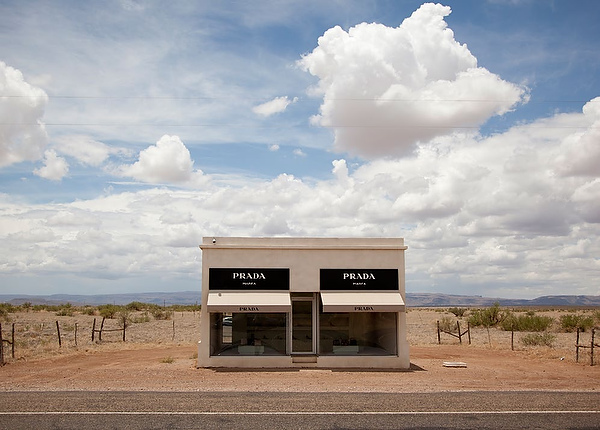
Motorists driving on U.S. 90 about 35 miles from Marfa will see the permanent land art project by artists Elmgreen & Dragset.
To be off the beaten path, Marfa and Chinati attract the world to the Chihuahuan desert. Visitors find a quirky array of food trucks, odd-combo businesses (see Buns and Roses for breakfast and floral needs; and the nondescript shop that offers computer repair/auto lube jobs), a liquor store but no pharmacy and emergency health care only available in the next town 40 miles away. Marfa has 15 cultural institutions, a Montessori school where the Moore girls attend and high-end restaurants, including lively Maiya’s and modernist Cochineal with its wine list that boasts a bottle of Saint-Julien’s 2009 Ducru-Beaucaillou for $435. Moore remembers looking around at Cochineal one night: “Chelsea Clinton was two tables over and a major art collector three tables over, and then you had a Texas rancher three tables next to that, and Jake Gyllenhaal came through to the bar.”
Marfa wasn’t always this way.
“It was a dying little cow town,” says Bob Wright, a former Georgia peanut farmer who is a broker and auctioneer at Marfa Realty & Auction. He made his home here with his Marfa-born wife — “I married a Marfan” — in the early ’90s “before everything went pah-ching.” By that he means real estate prices soared. He knows a home on the market priced at $895,000. Adobe and old concrete houses are coveted by out-of-towners with “the hardest homes to sell … the brick-veneer ranch style.” In February Moore told Wake Forest students on her first visit back to campus since graduation that she and her husband found Marfa real estate prices “more cutthroat than Brooklyn.” Art, culture, the quality of light draw people to a singular town whose majority of residents are Hispanic and whose boundaries are surrounded by ranch land.
“When everything started we had the old rancher, cowboy characteristics around here; and the two couldn’t be farther apart — you know, the artsies and the abstracts,” says auctioneer Wright. “They have blended very well.”
Part of that reason is Chinati. It kept Marfa “from becoming just a vacant little place in the road,” says Wright. Drive in any direction and you can see those dying towns that Marfa might have become had it not been for Donald Judd and his vision. Tim Johnson moved from Houston and owns Marfa Book Co., an independent bookstore and gallery space for art exhibitions and public readings. “For me, my business is not possible without Chinati,” he says, likening Marfa to a tree that has branches and nests. “They’re the root — especially for all of the art and music and poetry,” he says. “It definitely begins with Chinati.”
Judd didn’t live to see the fully blossoming art mecca or meet Chinati’s young executive director. He died of cancer in 1994 at age 64, leaving Moore these 20 years later to carry forward his legacy. What’s surprising: It’s not her first rodeo in Marfa. In one of the many twists of her career after Wake Forest, she spent June through August 2004 as a curatorial intern at Chinati researching John Chamberlain’s urethane foam sculptures for an exhibition and living in Apartment 13 near the artillery sheds on the Chinati property. She was studying for her M.A. from the Center for Curatorial Studies and Art in Contemporary Culture at Bard College, without a clue she would ever return to live in Marfa. “Never underestimate the power of an internship,” she says.

Among Marfa’s big attractions are sourceless lights that dance on the horizon at random. A viewing area is 10 miles east of town.
Her résumé lists an impressive range of jobs from small galleries to large institutions. She spent a semester at Casa Artom while she was at Wake Forest; that wound up helping her land a paid internship next door in Venice in 1998 at the Peggy Guggenheim Collection. That then led to a job as conservation coordinator at the Solomon R. Guggenheim Museum in New York. She worked for the Andy Warhol Foundation for the Visual Arts and worked on the Gwangju Biennale in South Korea.
“I remember graduating and thinking, ‘OK. It’s the morning after, but I don’t feel very different, but I don’t know what happens next. …’ There’s something inherently valuable in not having a plan. I learned to work with difficult people. I learned what my values were. … I feel like all of the disparate things I have done have coalesced to support the work I am doing here.”
To her astonishment, she’s back in Apartment 13, this time with her family, more square footage than in the Brooklyn apartment and with a one-minute commute to her office. No more struggling with strollers down the subway steps. No more rushing around at a crazy pace. As on this day, hers is an easy amble out the office door to greet Mae, who has just learned to ride a bike and is arriving home from school. “Hello, Bean!” Moore shouts. Larry Bamburg has little sister Willa in a seat on the back of his bike. He waves. The news: It’s dinner from Marfa Burrito ahead. Her children are happy in this “magic wonderland,” she says, despite the presence of “venomous insects and goats’ heads.” And none of it is foreign to Bamburg. He grew up in Houston and learned such Texas ways as picking up tarantulas without being bitten. Moore says, “We get up in the morning and we see the aluminum pieces and watch the sun rise.”
 She thrived in New York and understands well the ambition, the creative drive and the inspiration that comes when creative people bump into one another. “Here, you can’t help but understand how much larger everything else is than you are,” she says. Here, she pays attention to migratory patterns of birds, even the migration of tarantulas. Here, she tracks the passing of the day by the sun’s movement across the sky.
She thrived in New York and understands well the ambition, the creative drive and the inspiration that comes when creative people bump into one another. “Here, you can’t help but understand how much larger everything else is than you are,” she says. Here, she pays attention to migratory patterns of birds, even the migration of tarantulas. Here, she tracks the passing of the day by the sun’s movement across the sky.
Her New York friends are fascinated by how happy she is in Marfa. She has found like-minded people. “Making a life, for a lot of us it is about something creative. It is about engagement with the land, whether it’s ranching or making art,” she says. “Working in the arts, I don’t do it for money, and I don’t do it for security. I believe in it fundamentally, and that’s given me an incredibly rich life.”
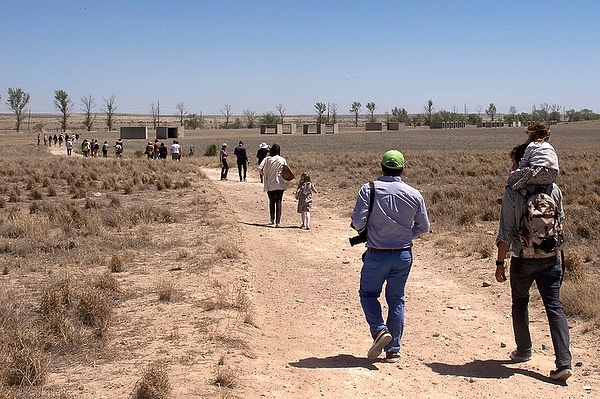
Visitors from around the world view the 15 concrete works that run along the border of Chinati’s property.
The family will be moving later in the year to a house with a 360-degree view whose seller is named May. It seemed an appropriate synchronicity in a burg full of them.
Just like the rest of the townsfolk, Moore and her family will head to the farmers’ market Saturday morning for a burrito, a baked croissant or “your goat-milk whatever” to watch the ranch hands lope by and the out-of-town hipsters cruise through.
“Everybody watches the parade,” Moore says, and she is fine with that. After all, she’s a Marfan now.




